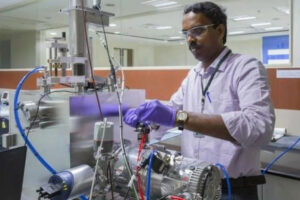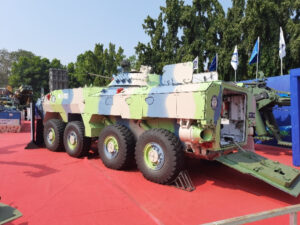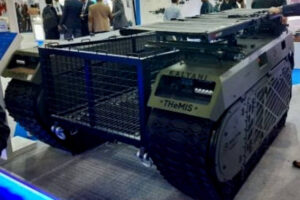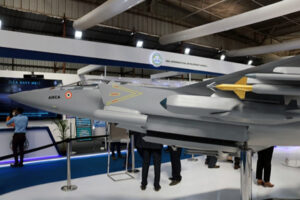Defence Indigenisation : A Work In Progress by Lt Gen Dushyant Singh (R)
![]()
Introduction
A strong and an operationally prepared Armed Forces that is committed to national cause is a prerequisite for transformation of India to the league of great powers. Future battle fields will be driven and shaped up by technology, not only as an enabler but also as a force multiplier, hence there is a need for India to invest in niche technologies as a ‘whole of nation’s approach’ including exploitation of dual use technologies for defence purposes, especially in the digital domain.

US Defence Forces highest ranking officer Gen Mark A. Milley, recently said while addressing the Defence Graduates at the National Defence University that, “Fundamental change in the character of war” is being driven by advances in sensors, robotics and artificial intelligence that give nations the ability to observe, orient, decide and act at ever increasing speed. Your success and the success of your and the survival of your nation will depend on how well we, all of us collectively, take advantage of these technologies and how we optimize them for use in the military.
” Indian Army’s equipment profile is probably lagging behind the other two services in terms of vintage equipment holding. As per the COAS, the Indian Army is holding around 41% vintage, 15% State of the Art and 44% current equipment and weapons. The Indian Army hopes to change this by 2030. However, given the financial constraints caused due to increasing revenue budget, capital allocation remains restricted. On the other hand, the AF, and the Navy due to smaller manpower profile, platform centric organisation and better planning have been able to allocate larger percentage for capital acquisitions. For example, the share of capital expenditure of the three services in 23-24 Year budget of the three service is 16% for the Army, 62% for the Navy and 57% for the Air Force. So the big question is how do we make up the requirements of the three services without overstretching our budget? The answer does not lie in the import route but by promoting indigenization, encouraging R&D, supporting the MSMEs/SMEs, and actively promoting the private and public sector partnerships. Towards this end the two Defence Corridors must be promoted rapidly if India must meet the target of indigenization and modern technology driven defence systems in an earlier time limit.
Measures to Hasten up the Indigenization (Atmanirbharta in Defence)
• Research & Development (R&D). R&D is a critical factor in indigenization in the defence. But the R&D is exorbitantly cost intensive and as such tax relief/ financial incentives could be considered to reduce the financial burden on the industry venturing into R&D in the defence sector.
• Creation of Support Infrastructures in the Defence Corridor. Creation of basic infrastructure to facilitate R&D work in Def Corridors may be considered by the State Government of UP and TN. In this regard the industry especially the private sector in conjunction with Academia and Govt nodal agency should establish specific facilities. The UP government has started working towards it, but the work needs to be expedited if we must become a significant power by 2047 the 100th year of our independence.

• Testing Infrastructure. This is a major aspect in development of defence weapons and equipment. Firing ranges for testing munitions need to be created/ made available to private enterprises by the Central and State Governments. The quantum of testing facilities especially the high technology labs that are NABL Accredited need to be created in larger numbers and provided to the private industries. For the interim technology needs to be leveraged to create virtual/ augmented reality-based labs for the testing and validation.
• Lower level User Developer Interaction especially for the Startups. Sub allotment of R&D funds to military formations to meet area specific weapon, equipment and systems requirements may be considered and funds allotted to the formations for this purpose. Entrepreneurs working on area-specific def requirements should be allowed to visit and spend time in the environment for which the weapons/equipment/system is required to be produced. However, while doing so, security angle needs to be kept in mind. In fact, a liaison Cell at MoD should be created wherein a particular industry may seek support to study area, interact closely with the user and necessity of an equipment should be cleared to visit the specific area and stay with the user to correctly understand the requirement.
• Trials. Trial duration of new items should be specified to avoid undue delay in the production process.

• A stringent system of certification needs to be created and followed for facilitating easier export of def related items. This system should progressively be developed to encourage self-certification.
• Skill Development. Some of the nodes of the Defence corridors have been created in tier 3 or 4 cities for example Aligarh, Chitrakoot and Jhansi which are not adequately endowed with skills needed for defence industries. Further, people living in tier1 & 2 cities would not like to relocate to such places unless the remunerations were extremely high. Therefore, greater emphasis on skill development to create a more efficient workforce needs to be considered. In the interim large skilled workforce available among the ex-servicemen, who are in younger age bracket should be utilized. In addition, major industries willing to create manufacturing facilities in the Defence Corridors should establish Centers of Excellence to reorient these skilled service men to train their respective industries.
• Encouraging smaller Vendor. There are several small vendors making components of international quality. However, at times their expertise cannot be exploited for big projects due to the cost factor/administrative issues related to reliance on multiple vendors for defence equipment. There is a need to explore cost effective avenues to use available expertise as part of the Atmanirbhar initiative. Hand holding of such vendors is the way ahead.

• Cooperation Across Agencies Involved in Development & Manufacturing. The Atmanirbhar initiative is investor friendly and transparent. However, since it’s still in the evolutionary stages, more frequent interaction between the govt agencies/ service HQ involved and manufacturers will lead to a better understanding of the requirements of both the user and industry.
• Incentivization of Defence Corridors. Defence Corridors especially in UP need to be incentivized with tax breaks and hand holding since they are going to be green field projects and MSMEs/SMEs do not have the capacity to sustain in a stand-alone manner. The big players like Adani, Tata Defence, Kalyani need to be encouraged to establish their manufacturing/ repair and maintenance base in these nodes and create the ecosystem for the MSMEs/SMEs to mushroom. In fact, as announced by TATAS that they would be establishing their MRO at Jewar will create a new eco system that will cater for not only India but also for South and Southwest Asia. Establishment of similar facilities will go a long way in addressing sustainability of manufactured equipment.
• Review of the No Cost No Commitment Concept (NCNC). NCNC concept involving design, development, and manufacturing especially for major weapon and defence equipment is not sustainable. Foreign systems such as those being followed in the US need to be studied and the contracts awarded keeping the Indian conditions in mind.

• Level Playing Field between Big and Small Players. The talent base in new India resides in the startups and smaller players specially in the defence sector. Especially those related to funding, especially in the UP def corridor including incubation centers which are unknown to small scale investors. Hence, regular interactions must be held, and smaller players taken on board by the government agencies to disseminate the facilities and incentives available in the defence corridor to establish an industry.
• Digital Sector. For cyber, AI, and EW, we need one central agency to coordinate activities of startups, which are mainly working in this field.
Conclusion
There are many areas that need to be addressed to propel the defence industry in making the Indian Armed Forces modern and indigenized such as funding, framing of realistic user requirements for example the insistence of the users that one equipment should be effective in all terrains. It must be realised that the weather and terrain conditions in our country vary from temperatures ranging from -30 to plus 48 to 50 degrees, from lofty heights of Siachen to the vast deserts of Rajasthan and from dense jungles of the east to the built-up area and riverine terrain of Punjab. It may be a promising idea to organize boot camps for all startups to understand defence operating procedure for procurement and development of new systems. It may also be noted that while the ease of doing business may have improved quite considerably but red tape, bureaucratic procedures still exist that discourage MSMEs/SMEs from undertaking work for Indian Defence requirements.
Given the practice of advanced nations applying sanctions against their adversary as seen in the Ukraine and Iran conflict, one cannot rely on import dependent armed forces. In addition, imported equipment come at an extremely inflated cost. Moreover, no country shares its top end technology to another nation while exporting defence equipment. Therefore, the equipment profile suffers qualitatively and financially. In addition, war stamina of a nation is held hostage to other nations not only for subsequent supply of equipment but in some cases for maintenance, repair, and operations. It is, therefore, prudent to lay emphasis on enhancing our indigenization capabilities in the defence sector as much as possible and in a faster period with fixed timelines.
“As a nation, if we devote ourselves to reinvigorate our scientific temper, create capacities and focus our efforts, I am quite certain that we can reap success in the defence sector as well”. Admiral DK Joshi, PVSM, AVSM, YSM, NM, VSM, Former CNS while addressing the Officers of College of Defence Management on 14 Dec 2012.
Lt Gen Dushyant Singh, PVSM, AVSM (Retd)  The writer was commissioned into the ‘NINTH BN OF THE MARATHA LIGHT INFANTRY REGIMENT’ in Dec 1981. Has attended the Regional Defence Counter Terrorism Programme with specialization in Terrorist Operations and Financing in US. Has served in varied terrains and theatre of operations in India and in the UN as Military Observer. Has commanded an Infantry Battalion, Brigade and a Division in Jammu and Kashmir. Also, holds the distinction of having served twice in the elite National Security Guards, as the Deputy Inspector General (Operations) and the Inspector General (Operations). Commanded a Corps in Punjab Sector and was the Chief of Staff of Eastern Command in Kolkata prior to retiring as Commandant, Army War College. Currently, is Prof Emeritus Rashtriya Raksha University, an Institution of National Importance. Is Working Vice Chairman of STRIVE INDIA, a Lucknow based think-tank and also an active member of various social organisations and NGOs.
The writer was commissioned into the ‘NINTH BN OF THE MARATHA LIGHT INFANTRY REGIMENT’ in Dec 1981. Has attended the Regional Defence Counter Terrorism Programme with specialization in Terrorist Operations and Financing in US. Has served in varied terrains and theatre of operations in India and in the UN as Military Observer. Has commanded an Infantry Battalion, Brigade and a Division in Jammu and Kashmir. Also, holds the distinction of having served twice in the elite National Security Guards, as the Deputy Inspector General (Operations) and the Inspector General (Operations). Commanded a Corps in Punjab Sector and was the Chief of Staff of Eastern Command in Kolkata prior to retiring as Commandant, Army War College. Currently, is Prof Emeritus Rashtriya Raksha University, an Institution of National Importance. Is Working Vice Chairman of STRIVE INDIA, a Lucknow based think-tank and also an active member of various social organisations and NGOs.
Disclaimer: The views expressed are those of the author and do not necessarily represent the views of the organisation that he belongs to or of the STRIVE.






Thankfully government has now created extremely liberal policy framework with supportive ecosystem and infrastructure. This will certainly attract industries for investment and defence indigenisation.
Nice article.